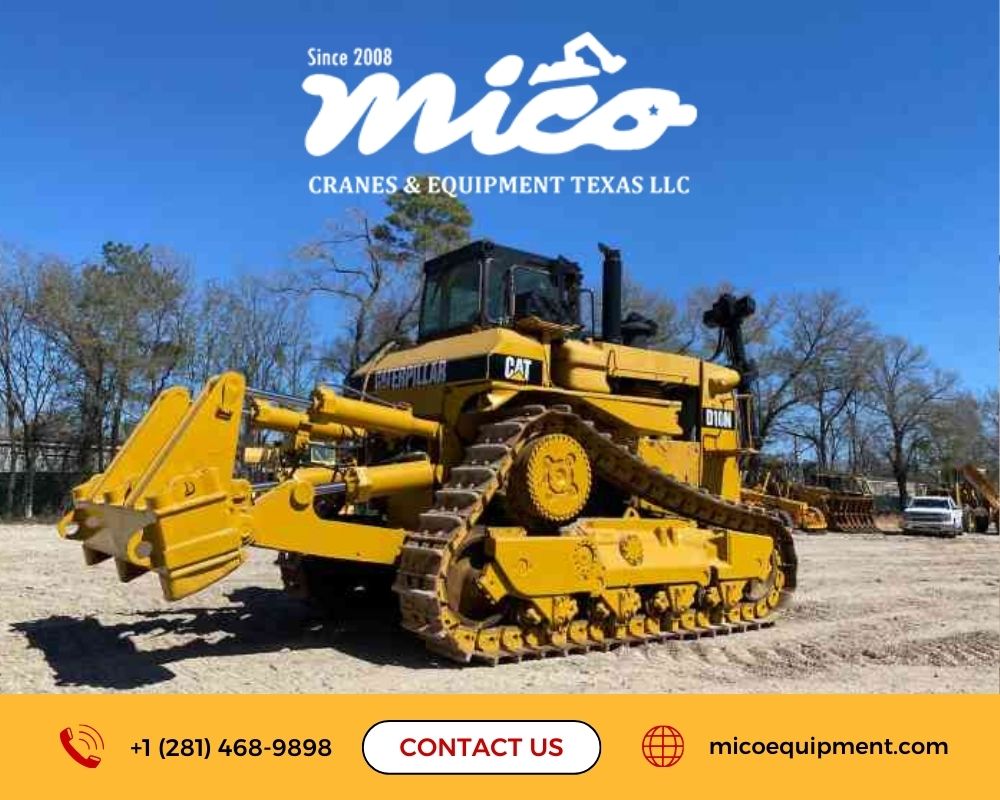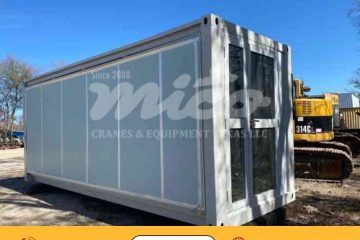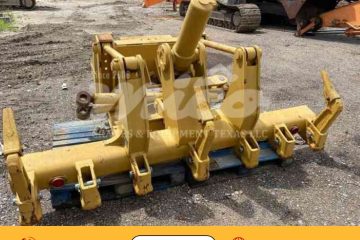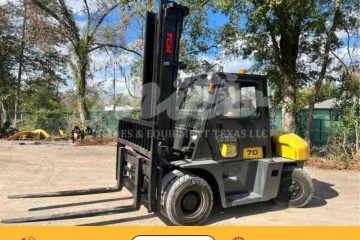Bulldozer Types, Parts and Uses

Bulldozers, the prime pillars of construction, empower with unparalleled capabilities and precision to reshape landscaping and support diverse industries. However, their robust engineered parts of towering blades to hydraulic systems can easily tackle rigorous tasks. Mico Equipment is the top leader in providing quality-assured used bulldozers for sale in Texas’s local and international markets.
This exploration focused on providing technical comprehension of its technical features, dynamic types, industrial application, and professional tips for handling. Definitely, this guide assists the readers in selecting the appropriate heavy construction machines like bulldozers according to their unique project demands.
Overview of Bulldozer and Historic Evolution
Bulldozers act like giants to dig, push, lift, and level soil and debris from construction sites with great efficiencies and extensive hours. Impactfully, their versatility of usage extends to applications for the mining industry, forestry sector, and disaster relief practices worldwide. These earthmoving machines’ rigged material and size enable the operators to move heavy loads around easily. Additionally, some attachments are integrated to perform personalized tasks.
Agricultural tractors with large blades have evolved remarkably to 20th-century hydraulic control bulldozers. However, its historic evolution involved continuous upgradation to pursue efficiency in construction and develop indispensable assets.
Understanding Key Components and Technical Specifications
Well, these massive designs are considered workhorses of construction sites, fortified with innovative technical specifications and components for outstanding performance. In fact, this exploration enables the project managers to understand the bulldozer make and optimize capabilities for different jobs.
Bulldozer Engine Power
Obviously, conducting challenging operations on dynamic terrains requires a durable engine to handle heavy loads and maneuvers. Typically, a diesel-powered engine is installed with 80 horsepower for mini designs and over 1,000 horsepower for heavy-duty models. Hydrostatic or powershift technique is utilized to seamline tracks.
High-pressure hydraulic fluid manages blade and ripper movements at variable flow rates. Ground clearance support ranges from 12 to 24 inches. Maximum speed limits are 6 to 11 miles per hour with joystick-controlled steering. Also, it upholds more than 100 tons of loading capacity.
Blade Dimensions and Capacity
The blade is the primary tool for pushing objects, digging soil, and leveling materials for on-site jobs. Moreover, various shapes of blades are available with widths ranging from 8 to 24 feet.
Blade capacity is measured in cubic meters, based on the volume of load that has to be transported. Blade size and shape definitely impact material handling capabilities.
Counterweight Balancing
Operating weight includes the total weight of the bulldozer, which may cover the weight of additional adjustments to perform personalized tasks. Indeed, average weight limits range from 7,000 to 100,000 pounds, according to size. However, a mid-sized earthmover weighs between 20,000 and 40,000 pounds.
Obviously, the weight of heavy-duty equipment influences the machine’s equilibrium, traction stability, and capabilities to work on challenging terrain. Well, heavier bulldozers provide better traction and stability for earthmoving tasks.
Customized Track System
The track system consists of wheels or base support, providing traction assistance on different surfaces. Importantly, the width of the track impacts the stable moves that can tolerate the equipment weight and loading materials weight. Bulldozer tracks are crafted and installed in various dimensions and configurations to access sensitive job sites.
Ripper Functionality
Rippers, mounted at the back of the bulldozer, enable the device to break down rocks and compact soil to prepare land for agricultural purposes. Typically, it is fabricated as single or multi-shank configurations with replaceable tips to meet tailored needs.
Commonly, the maximum ripping depths range from 1 to 6 feet, and the exerted hydraulic pressure is 2,000 to 5,000 psi. In fact, to maintain tool durability and strength, it is composed of steel alloys.
Importance of Final Drive
The final drive mechanism involves the equal distribution of the lifted lad to each gear tooth to make the safe and stable movement of the motor drive away from suspension. Therefore, planetary or spur gear design is incorporated, which can multiply torque from the reverse to the tracks.
Proper seating is essential to prevent leakage of the lubricants used in cooling systems. Impactfully manage the transmission of power to tracks.
Operator-Centric Cab Design
The bulldozer’s cab acts as the brain of the heavy-duty machinery to operate the movements and task executions. In fact, the manufacturers use rugged steel material with a rollover safety feature. Furthermore, large windows and side mirrors are mounted for optimal visibility.
Ergonomically designed seating and air conditioning systems with noise control guards are paramount—likewise, the joystick or lever controls for friction-free smooth adjustments of the blade and ripper. The vivid LCD screens are equipped to monitor performance parameters and hydraulic system conditions.
Various Replaceable Blade Shapes
Bulldozers are heavy-duty earthmoving equipment fortified with replaceable blades according to work demand. Indeed, the distinctive shapes and configurations are optimized for specific grading functions for land clearing. Understanding each type enables the readers to select the suitable blade for their project requirements.
- Straight Blade
- This is the most common and extensively used blade for versatile task execution.
- A straight blade is the most common and versatile type of blade found on bulldozers.
- It’s a flat, straight edge extending across the bulldozer’s front width.
- suitable for general earthmoving jobs with material grading and leveling.
- They effectively push the material forward and spread across the desired areas.
- U Shape Blade
- U-blades, or universal blades, have curved shapes similar to the letter U.
- These blades have a high surface area and improved carrying capacity. Therefore, lifting loose soil, sand, and gravel particles is considered an idea.
- commonly used in mining and commercial-scale earthmoving projects with high demands and efficiency.
- Semi-U Shape Blade
- These are the hybrid versions of straight and U-blade designs.
- They feature a curved shape similar to a U-blade but with a less pronounced curvature.
- Semi-U blades improve the U-blades’ carrying capacity and flexibility compared to straight blades.
- They are suitable for construction excavation, backfilling, and load handling.
- Angle Blade
- The hydraulic control mechanism is incorporated to manage angle blade movement from left to right with the desired angle.
- The precise adjustments of these blades allow them to perform diverse functions ranging from ditching, backfilling, and sloping in different terrains.
- Road construction, landscaping, and snow removal projects took practical support from angle blades.
- Power-Angle-Tilt Blade
- PAT blades are fortified by the combined effect of angle blades with the improved to move forward and backward along with left-to-right movement.
- This innovative characteristic enables great flexibility and precise control over shaping grade slopes terrain.
- PAT blades are highly versatile and commonly used in grading, trenching, and fine-grading applications where precise blade positioning is essential.
Each blade attachment offers unique uses and functionalities. Therefore, the users can select the most suitable one depending on their project requirements and needs. Hopefully, this content is enough to understand the basic differences in blade structure and implementations.
Different Bulldozer Types and Their Field Applications
There is a diverse range and design of bulldozers available in the Texas market, including new and refurbished machines fitted with original spare parts. Each type has different technical features and work specifications. Well, the choice is based on exact requirements that resonate with the desired job.
Crawler Bulldozers
Crawler bulldozers are equipped with tracks or treads instead of wheels to maintain superior traction and stability even on challenging terrains. Importantly, they are suitable for heavy construction, forestry, and mining operations to perform complex earthmoving tasks efficiently.
Technical Features
- Equipped with different sizing tracks for balance and stable traction to accommodate different site terrains.
- Heavy-duty undercarriage structure to perform loading provisions for long hours.
- Rugged material of the body and adjustment enables it to work in severe working surroundings.
- Available in diverse blade capacities models ranging from small to large.
- 80 to 500-horsepower engines make them complimentary assets for demanding tasks.
Field Applications
It is ideal for earthmoving, material grading, and soil leveling tasks. Suitable for struggling construction projects, commonly for remote or limited access areas due to improved traction system. Planted at sloppy terrains, mining, and landscaping.
Wheeled Bulldozers
These powerful tools have wheels to move speed in flat and paved locations. Therefore, it is easily transported to urban development and road maintenance services. Also, agricultural users are the prime applicants for stable mobility and versatility of jobs.
Technical Features
- Equipped with rubber wheels for considerable speed and maneuverability on smooth surfaces.
- articulated and rigid frame and wheel configurations make it adaptable for different sites.
- Blade capacity, shape, and dimensions are similar to crawler bulldozers for heavy-duty weight lifting.
- Engine power is improved to meet the proficiency limits and typically ranges from 100 to 600 horsepower (HP).
Field Applications
Well-suited for urban development and road maintenance projects. Likewise, it delivers maximum yield in the agriculture and landscaping industry. Optimal performances are achievable at flat and stable ground surfaces.
Mini Bulldozers
They are referred to as compact or mini-dozers due to their smaller size and accessible maneuverable versions of conventional bulldozers. They are characterized by their compact size, lightweight design, and rubber tracks, allowing them to easily access tight spaces and navigate confined areas. Mini bulldozers are commonly used in landscaping, residential construction, and utility installation projects requiring precision and agility.
Technical Features
- Compact design for maneuverability in confined spaces and tight job sites.
- Typically equipped with rubber tracks for minimal ground disturbance and improved traction.
- Smaller blade capacity than larger bulldozers, ranging from 0.5 to 2 cubic yards.
- Engine power ranges from 30 to 100 horsepower (HP).
Field Applications
The compact design of the mini bulldozer is appropriate for landscaping, trenching, and residential-scale earthmoving tasks. Also, it supports urban renovation and utility distribution and installation projects. The farming sector can integrate these dozers for land preparation and soil leveling.
Mulcher Bulldozers
These powerful, heavy-duty machines compatible with land clearing and vegetation jobs. Mulching attachments improve their capabilities for grinding and shredding vegetation. Therefore, there is ideal technical support for land development, agriculture, and natural disaster restoration projects.
Technical Features
- Equipped with multipurpose mulching accessories for farming operations and land clearing.
- Additionally, heavy-duty mulching mounting with rotary cutters shreds the thick vegetation and trees.
- Enhanced cooling systems manage the overheating problem that can arise during mulching operations.
- Variable track dimensions and flexible adjustment options enable you to navigate diverse terrains.
- Engine power of 200 to 600 horsepower (HP) to backing mulching operations.
Field Applications
Mulcher bulldozers are ideal heavy-duty construction equipment for practical utility in forestry, land reclamation, and the vegetation management. Also, pipeline construction is supported with these dozers to prepare and clear the land.
Hybrid Bulldozers
Hybrid bulldozers are an intricate blending of traditional combustion engines with electric power motors to reduce fuel consumption and reduced emissions. We are conveniently utilized for urban development projects with controlled ecological footprints.
Technical Features
- These are cost-efficient options with environmentally sensitive approaches.
- Energy storage mechanisms are stored in batteries or capacitors and utilize electric power during operation.
- Regenerative braking systems save energy and reuse during deceleration.
- Variable power modes outthrow optimal performance based on operating conditions.
- 150 to 400 horsepower engine power augmented by electric thrust systems.
Field Applications
Suitable for construction projects where the availability of resources could be improved. Also, it is a resonating substitute for using resources sustainably. Practically, it is a reliable technology to meet the strict emission standards in urban areas. Also, it is an effective heavy machine for sale for extensive and elaborated workloads.
Shiphold Bulldozers
We designed explicitly for off-shore operations in port areas and confined spaces. Indeed, the essential provision is to facilitate well-organized cargo handling and logistics services at maritime terminals.
Technical Features
- Compact structure with rugged construction to perform heavy-duty tasks in limited workspace.
- High performance and accuracy with articulated frames for maneuverability.
- Counterweight lowered the gravity factor and stabilized movement on uneven surfaces.
- Specialized accessories can be installed for cargo handling and material lifting.
- Shipboard operations are accommodated with a 100 to 300-horsepower engine.
Field Applications
I was used for loading and unloading services in ports and maritime terminals for cargo and container operations. Also, it was involved in housekeeping shipholds and arranging material in stores.
Definitely, an in-depth understanding of all bulldozers makes for technical features and field applications, enabling industries to improve work efficiency and operational productivity.
Bulldozer Buyer’s Guide: Choosing the Suitable Heavy-Duty Machine
The prime focus is selecting a suitable bulldozer that can deliver optimal performance and work efficiency for your specific earthmoving projects. This comprehensive buyer’s guide assists the customer to manage their resources sustainably and make value-adding additions to their equipment fleet. Mico Equipment company professionals suggest that clients appropriately use heavy construction machinery for sale in Texas.
Outline the Basic Needs of Your Project
Before choosing a device to perform necessary tasks, it is suggested to underscore the prime facilities you want for your project. Therefore, assessing the specific supplies of your project is paramount. In fact, the managers should examine the nature of soil and terrain type, the construction area’s size, and the required outputs.
Furthermore, executives should consider the type and volume of objects that have to be transported, the compulsory blade proportions, and the essential attachments looked for.
Check Market Available Bulldozer Specifications
However, the bulldozer manufacturers have supplied various machines with different technical features and work-performing proficiencies. Moreover, the structural designs are compact models for limited space to large, heavy-duty machines. Likewise, the engine powers are different.
Always select an earthmover size and power rating that resonates with your project scale and operational complexities. Therefore, evaluate the proposed equipment engine horsepower strength, blade adjustments, and gross weight to ensure adequate productivity.
Evaluate Blade Type and Configuration
Well, if you have to work in rocky areas or sloppy terrains, go for an appropriate blade type that can perform well in such challenging tasks. Conversely, the straight blades are suitable for smooth surface earthmoving operations. Additionally, U-blades cover and transport massive volumes of loose materials.
Furthermore, angle and PAT blades are suggested for versatile grading, ditching, and slope shaping with adequate speed. Also, integrating hydraulically managed adjustable ensures adequate tilting and moving capabilities.
Consider Traction and Site Location
The choice of tracks or wheels depends on the proposed work area’s location and the soil’s nature. The wheeled bulldozers can definitely be transported to the site without transportation costs. However, bulldozer tracks can give stable moves in watery and muddy terrains.
Value Safety Features and Workload
The ergonomically sound structures of the cab invite the workers to be in a comfort zone and have safety protection to deliver maximum outputs. Likewise, the hydraulic controls of the steering and joystick provide vigilant and swift coordination with moving parts.
Look for additional features such as air conditioning to tolerate severe surrounding temperatures and installation of sound guards to reduce noise and vibration levels. Furthermore, proper window sizing and back-view mirror adjustments improve the visibility factor.
Also, ensure that the desired bulldozer is equipped with a rollover protection system and a falling object protection system for operators’ protection in accidents or rollovers.
Supplier Maintenance Support
Indeed, reliable manufacturers support clients with initial installation, regular maintenance service, and troubleshooting services in case of emergencies. Likewise, it provides original spare parts and technical support.
Therefore, connect with a reputable manufacturer or used construction equipment dealer for experienced maintenance and malfunctioning repair support to reduce downtime and improve device longevity. Also, examine warranty coverage and service contracts to avoid future inconvenience.
Manage Budget Considerations
Finally, consider your budget, the total cost of buying that bulldozer, and initial installation and post-maintenance service expenses. Definitely, upfront costs are essential; also, check long-term upkeeping and operating costs to evaluate that the preferred bulldozer provides more return over investment.
However, carefully gauging your project requirements, watchful technical evaluations, and background assessment of required adjustments enable the users to make conscious decisions.
Texas Famous Brands and High-Performance Models of Bulldozers
In the local and international markets of new or used construction equipment, some brands are considered the name of quality assurance and customer satisfaction. Obviously, in the domain of heavy-duty bulldozers or earthmoving, the selection criteria are high performance and work efficiency.
- Caterpillar (CAT)
CAT D6T: is multipurpose and optimal performance equipment used in dozing, grading, and land cleaning tasks with precision and low fuel consumption.
CAT D8T: Renowned for its compact and rugged design and stable traction, this dozer is definitely an ideal substitute for extensive earthmoving and landscaping jobs.
- Komatsu
Komatsu D61: The Komatsu D61 bulldozer is an inevitable asset in smart energy use and advanced technology; therefore, it is considered the most suitable choice for Texas’s construction projects.
Komatsu D65: With its improved horsepower engine and unique technical features, this design delivers extraordinary performance and consistency in tough environments.
- John Deere
John Deere 850K: These bulldozers blend high power and precision to manage extensive operations ranging from grading and excavation for road construction to land clearing.
John Deere 950K: is a durable model with ergonomic Excel and conducts heavy-duty operations in severe surrounding environments.
- Case Construction
Case 1650M: Recognized for rugged component chassis and advanced technical specifications to manage earthmoving and grading project features with the least fuel and resource consumption.
Case 2050M: marketized with hybrid power and maneuverability, this model excels at being implanted at commercial-scale construction and mining sites.
- Liebherr
Liebherr PR 746: Claims upgraded recent interventions with operator-friendly ergonomic design, providing them with outclass comfort while working in harsh environments for long hours.
Liebherr PR 756: With its high horsepower engine and resonating blade capacity, the PR 756 bulldozer meets demanding earthmoving requirements.
These are just a glimpse of the most popular makes and models of bulldozers with high performance and customer reliance. However, thousands of manufacturers in this industry provide varying specifications and abilities to suit different project necessities and budgets.
Professional Handling Tips to Keep Bulldozer Well-Performing
Proper and careful handling and maintenance are important cautions to keep the device performing well for a longer duration without failures and downtimes. Indeed, the cautious use of used heavy construction machinery can deliver extra mileage and outthrown like new ones.
Conduct Inspection and Maintenance
Importantly, the regular inspections could be physical or technical evaluations of the outer parts for wear and tear signs. Additionally, the professional examinations include engine test drives, hydraulic system accuracy and control, smoothness of tracks or tires, and blade capabilities.
Well, routine maintenance protocols are essential to keep optimal performances. Therefore, the operators are recommended to monitor and manage lubrication, hydraulic fluid checks, filter change, and conveyor belt adjustments with expert protocols.
Regularly Monitor Fluid Levels
Check the engine oil levels and condition, hydraulic fluid density and visibility test, and coolant integrations regularly. In fact, the density and visibility are performed to check the involvement of contaminants as this equipment is working in dusty surroundings. If not replaced time-to-time can create choking into the hydraulic hoist and engine pipelines.
Manage Tracks or Tires Condition
Obviously, the physical examination of the tracks or tires for signs of wear, potential damage, or any irregular patterns is essential to keep stable moves and workloads.
Replace damaged tracks or tires adequately to maintain traction firmness and transport stability, reducing the chances of accidents and equipment failures.
Update and Maintain Blade
Also, the caretaking protocols are important for the upkeeping of the bulldozer blade. Therefore, keep them clean from debris after operations to mimic corrosion and ensure optimal cutting performance.
There are various blade shapes and types to facilitate the different tasks. Always select the suitable adjustment for overall material cutting outputs.
Use at Optimal Speeds and Loads
Avoid operating heavy-duty construction equipment at excessive speed limits. Also, don’t push or pull loads that exceed the weight range of that device. Well, such deeds can impact the engine’s performance, command transmission, and coordination with associated components.
Comply with Safe Operating Procedures
Follow local and international safety guidelines specifically outlined for the bulldozer’s operator. Furthermore, consult manuals and reference material relevant to safety regulations.
Likewise, use required personal protective equipment (PPE) and operator training and certification programs to keep bulldozer operations safe and well maintained.
Avoid Overworking the Bulldozer
Always conduct operations while staying within safe speed or loading limits to avoid overheating the bulldozer engine or traction belt. Well, give excellent down time to equipment if you have to perform for long hours. Likewise, use the bulldozer within defined capabilities and avoid going beyond its limits to avoid mechanical failures.
Schedule Fault Detection and Servicing
Address malfunctioning or abnormalities in the bulldozer’s performance readily to control future inconveniences and emergencies. Definitely, the latter cost is much higher than the repair cost. Similarly, noticing any change in noise and vibration levels could be a warning sign.
Schedule prompt equipment servicing and maintenance appointments with certified technicians to detect the error at earlier stages. Additionally, keep a comprehensive record of maintenance and troubleshooting practices for reference and warranty purposes.
Wrap-Up: Unlock Potential of Used Construction Machinery for Sale
Bulldozers are indispensable assets in high-productivity industries, providing unparalleled capabilities to reshape landscapes and construction sites. Definitely, these are robust engineered devices with adjustable parts, versatile makes, and dynamic applications. Well, these earthmoving drives maximum efficiency and productivity.
For those seeking to connect second-hand construction equipment for sale, Mico Equipment is a renowned company with decades of experience and customer satisfaction. We provide top-notch used bulldozers for sale, with warranty coverage and customer support. Indeed, the experts guide you through technical details to installation service.


